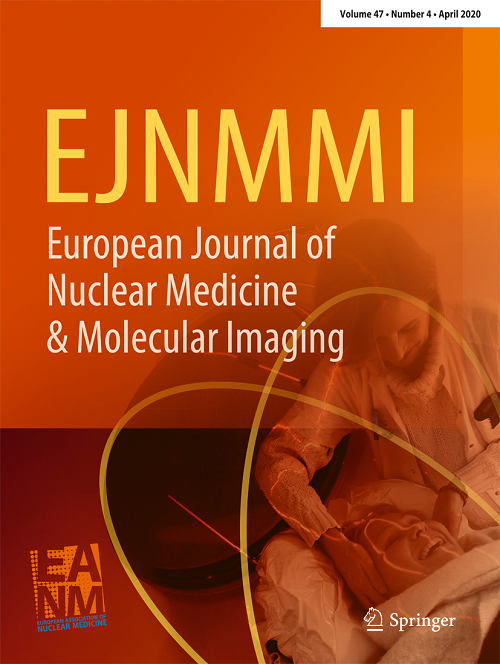Digital versus analogue PET in parathyroid imaging: comparison of PET metrics and machine learning-based characterisation of hyperfunctioning lesions (the DIGI-PET study).
IF 7.6
1区 医学
Q1 RADIOLOGY, NUCLEAR MEDICINE & MEDICAL IMAGING
European Journal of Nuclear Medicine and Molecular Imaging
Pub Date : 2025-08-22
DOI:10.1007/s00259-025-07508-4
引用次数: 0
Abstract
PURPOSE To compare PET-derived metrics between digital and analogue PET/CT in hyperparathyroidism, and to assess whether machine learning (ML) applied to quantitative PET parameters can distinguish parathyroid adenoma (PA) from hyperplasia (PH). METHODS From an initial multi-centre cohort of 179 patients, 86 were included, comprising 89 PET-positive lesions confirmed histologically (74 PA, 15 PH). Quantitative PET parameters-maximum standardised uptake value (SUVmax), metabolic tumour volume (MTV), target-to-background ratio (TBR), and maximum diameter-along with serum PTH and calcium levels, were compared between digital and analogue PET scanners using the Mann-Whitney U test. Receiver operating characteristic (ROC) analysis identified optimal threshold values. ML models (LASSO, decision tree, Gaussian naïve Bayes) were trained on harmonised quantitative features to distinguish PA from PH. RESULTS Digital PET detected significantly smaller lesions than analogue PET, in both metabolic volume (1.32 ± 1.39 vs. 2.36 ± 2.01 cc; p < 0.001) and maximum diameter (8.35 ± 4.32 vs. 11.87 ± 5.29 mm; p < 0.001). PA lesions showed significantly higher SUVmax and TBR compared to PH (SUVmax: 8.58 ± 3.70 vs. 5.27 ± 2.34; TBR: 14.67 ± 6.99 vs. 8.82 ± 5.90; both p < 0.001). The optimal thresholds for identifying PA were SUVmax > 5.89 and TBR > 11.5. The best ML model (LASSO) achieved an AUC of 0.811, with 79.7% accuracy and balanced sensitivity and specificity. CONCLUSIONS Digital PET outperforms analogue system in detecting small parathyroid lesions. Additionally, ML analysis of PET-derived metrics and PTH may support non-invasive distinction between adenoma and hyperplasia.数字与模拟PET在甲状旁腺成像中的应用:PET指标和基于机器学习的功能亢进病变特征的比较(DIGI-PET研究)。
目的比较数字和模拟PET/CT对甲状旁腺功能亢进的PET衍生指标,并评估机器学习(ML)应用于定量PET参数是否可以区分甲状旁腺瘤(PA)和增生(PH)。方法从179例患者的初始多中心队列中,纳入86例,包括组织学证实的89例pet阳性病变(74例PA, 15例PH)。定量PET参数——最大标准化摄取值(SUVmax)、代谢肿瘤体积(MTV)、靶本比(TBR)和最大直径——以及血清PTH和钙水平,使用Mann-Whitney U测试在数字和模拟PET扫描仪之间进行比较。受试者工作特征(ROC)分析确定了最佳阈值。ML模型(LASSO,决策树,高斯naïve贝叶斯)在统一的定量特征上进行训练,以区分PA和ph。结果数字PET检测到的病变明显小于模拟PET,代谢体积(1.32±1.39 vs. 2.36±2.01 cc; p 5.89和TBR bb0 11.5。最佳ML模型(LASSO)的AUC为0.811,准确率为79.7%,灵敏度和特异性平衡。结论数字PET对甲状旁腺小病变的检测效果优于模拟系统。此外,pet衍生指标和PTH的ML分析可能支持腺瘤和增生的非侵入性区分。
本文章由计算机程序翻译,如有差异,请以英文原文为准。
求助全文
约1分钟内获得全文
求助全文
来源期刊
CiteScore
15.60
自引率
9.90%
发文量
392
审稿时长
3 months
期刊介绍:
The European Journal of Nuclear Medicine and Molecular Imaging serves as a platform for the exchange of clinical and scientific information within nuclear medicine and related professions. It welcomes international submissions from professionals involved in the functional, metabolic, and molecular investigation of diseases. The journal's coverage spans physics, dosimetry, radiation biology, radiochemistry, and pharmacy, providing high-quality peer review by experts in the field. Known for highly cited and downloaded articles, it ensures global visibility for research work and is part of the EJNMMI journal family.

 求助内容:
求助内容: 应助结果提醒方式:
应助结果提醒方式:


